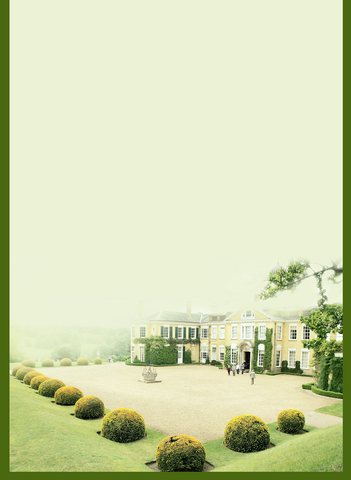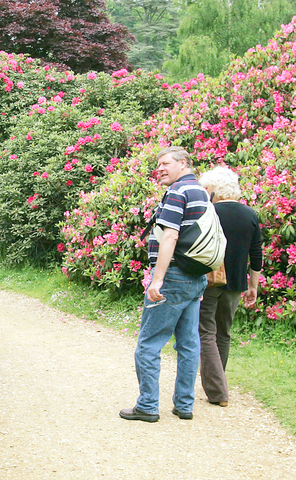It had been a long day. My 71-year-old mother had flown overnight from the US to visit her expatriate daughter and her three grandchildren, arriving as the sun was beginning to come up in London. But instead of letting her take a nap, or even grab a cup of coffee, we had stuffed her into the back of a minivan for a 40-minute journey to the cottage I had rented for a week in the English countryside.
Soon after we arrived -- as I struggled in vain to unlock the old Dutch door of the Garden Cottage on the Polesden Lacey estate in Surrey, about 32km from central London -- I began to wonder if we had made a grave mistake. I had rented a country house from the National Trust, England's century-old charitable foundation responsible for protecting and maintaining some of the nation's most precious stately homes, castles and gardens for the visiting public. But from the rear entrance, it did not appear to have "privileged views" onto a formal garden, as described on the National Trust Cottages Web site, where I had spent the better part of a day browsing through the photographs and descriptions of at least 50 of the trust's 323 rental properties around Britain. Rather, the former gardener's cottage seemed to be surrounded by nothing more than a field of dying daffodils and some abandoned farming equipment.
But after my 13-year-old had taken the keys and opened the back door as if she'd lived in this house all her life, it was clear I had made the right choice. At a little past 6pm, with the gates to the main estate locked up for the night, and all the visitors gone for the day, the place was ours.

As the current tenants of the Garden Cottage, which in the mid-1900s housed the head gardener responsible, along with 15 others, for pruning and trimming the acres of formal gardens and lawns now so artfully laid out before us, we were, literally, the lords, or rather ladies, of the manor. Until the house reopened at 11am, we had the gardens to ourselves.
With the sun starting to set over the deep vale in the distance, we strolled into the walled rose garden, where our brochure informed us the Duke and Duchess of York (later George VI and Queen Elizabeth, the late Queen Mother) took walks during their honeymoon in April 1923. They were visiting Polesden because it was the home of their close friend Ronald Greville, a legendary Edwardian hostess who with her husband bought the 19th-century Regency manor house in 1906. She bequeathed it to the National Trust in 1942. Walking under the rose pergola toward the ornate center fountain, sipping glasses of champagne, we could hear the children giggling as they rolled down the hill to the croquet lawn just below.
"Don't you just feel like Elizabeth Bennet at Netherfield," my mother, a Jane Austen fanatic, whispered. "However did you happen to find such a place for let?"

PHOTOS: NY TIMES
"Wow," I thought. My Michigan mother was suddenly speaking like someone from 19th-century England. "The Internet," I answered, hoping to bring her back to the future.
In fact, I had had no idea what was in store for us when I'd perused the Holiday Cottages Web site two months earlier -- a slide show of former servants' quarters, mills, lighthouses, stables and carriage houses all over England, Wales and Northern Ireland -- after being told by a British friend about the possibility of renting one of these properties for a vacation.
But I figured that the houses would probably be one step above a bad B&B -- musty curtains, faded paisley furniture, dangerous electric heaters and the lingering smell of what the English call "damp," and we Americans "mold." Instead, we were now occupying a charming cottage that smelled as fragrant as a Crabtree & Evelyn store, and decorated so tastefully it looked right out of a Laura Ashley catalog. What's more, we would be here for seven glorious days.

In the end, I had chosen the Polesden Lacey cottage not just for its proximity to London (I wanted my husband, who was working there, to "train up to the country" for a night or two) but also because of the price. On the National Trust tariff scale, which ranges from one to 22, this house was an 18 and cost roughly US$1,655 for the week. It also slept six. This seemed like a good deal, particularly for my mother, who had a wallet full of weak US currency to convert into English sterling at the disturbing rate of nearly US$2 to the pound. Still, I worried when we arrived that I should have chosen a more expensive, larger property -- until we entered the back door that opened onto the kitchen.
My eyes fell first on the large antique farm table and then took in the wooden ceiling beams, soft floral curtains and finally a large tray set with all the trimmings for afternoon tea, including chocolate chip cookies. A handwritten note from Jacqueline, the caretaker, welcomed us and urged us to call if we had "any problems or queries."
The rest of the three-bedroom house was anything but disappointing, decorated in antiques and soft furnishings of gray, rose and cream entirely in keeping with the Edwardian period of the cottage, down to the silver hand mirror on the dressing table in my room. A pile of wood sat beside the living room fireplace, and a vase of fresh flowers graced the coffee table, set between two overstuffed sofas.
"I always tell friends that when you walk into one of the National Trust rental properties, it feels like the three bears have just left," said Michelle Arnot, who has stayed in a dozen of their properties over the last seven years, including the Ferry Cottage on the grounds of Cliveden, the former home of Lady Astor. "Basically, it is a vacation that appeals to a person who really likes Masterpiece Theater. It is like a fantasy. When you get there you step into another era."
Indeed, moments after our arrival, I watched as the children disappeared behind a row of boxwood hedges, having been given directions to various secret paths by a young gardener working on the property.
I knew right then that I had succeeded in finding a different type of family vacation -- one that did not revolve around an expensive resort, fighting over pool chairs and deciding which of the on-site restaurants to dine in that night. Here we'd have all the creature comforts of a house (though my mother did flood her bathroom one morning after wrestling with a nozzle shower head in a roll-top tub), as well as the countryside to explore. What's more, this trip promised educational value for both young and old; we planned to visit as many of the National Trust's stately homes nearby as possible.
The next day I watched in amazement as my three computer-obsessed children (aged 13, nine and eight) happily grabbed one of the kids' quizzes from the docent at the front entrance of Polesden Lacey. As the children chatted amicably with the various elderly volunteers stationed in each room, trying to learn the answers to their two pages of questions, my mother and I wandered through the house at leisure.
"A lot of our guests are families who have done the resort holidays and are tired of the artificial environment," says Richard Day, head of holidays for the National Trust, adding that about 5 percent of their bookings come from Americans. "You can choose to explore any part of England from the Cotswolds to the Lake District to the coast and actually stay in a piece of history. It is a total break from the modern world." (Of course, most trust properties have modern conveniences, from microwaves to VCRs, soon to be replaced by DVD players.)
"A National Trust vacation is probably not for everyone," said Antoine Bourbon-Parme, a New Yorker who has stayed in nearly two dozen trust properties over the last decade. "Don't expect to be able to find an open restaurant on Sunday evening in your local village or very wide roads. But do expect to have a wonderful time in a beautiful house and commune with nature."
In fact, though we had rented various period-piece videos for our evening's entertainment (Emma, Pride and Prejudice and Howards End to name a few), we were hard pressed to get the children indoors for even one movie night. Instead they would appear briefly for dinner (my mother unwittingly began cooking turn-of-the-century British food -- roasting huge cuts of meat, mashing boiled root vegetables and stewing fruit) and then go back out to continue their imaginary games.
Five days into the week, we were proudly visiting our seventh National Trust stately home (Clandon Park, famous for once being the home of the Onslow family, which during the late 17th and 18th century provided the House of Commons with three people who held the title of speaker), when my eldest daughter turned to her grandmother and said, "I have National Trust Syndrome." Her two siblings nodded their weary heads in agreement. "All these houses are starting to look alike to us," she said, crumpling up her latest quiz and throwing it at her brother, who folded his into a paper airplane and sent it down a three-story staircase. It was a miracle that it had not happened sooner.

On April 26, The Lancet published a letter from two doctors at Taichung-based China Medical University Hospital (CMUH) warning that “Taiwan’s Health Care System is on the Brink of Collapse.” The authors said that “Years of policy inaction and mismanagement of resources have led to the National Health Insurance system operating under unsustainable conditions.” The pushback was immediate. Errors in the paper were quickly identified and publicized, to discredit the authors (the hospital apologized). CNA reported that CMUH said the letter described Taiwan in 2021 as having 62 nurses per 10,000 people, when the correct number was 78 nurses per 10,000

As we live longer, our risk of cognitive impairment is increasing. How can we delay the onset of symptoms? Do we have to give up every indulgence or can small changes make a difference? We asked neurologists for tips on how to keep our brains healthy for life. TAKE CARE OF YOUR HEALTH “All of the sensible things that apply to bodily health apply to brain health,” says Suzanne O’Sullivan, a consultant in neurology at the National Hospital for Neurology and Neurosurgery in London, and the author of The Age of Diagnosis. “When you’re 20, you can get away with absolute

May 5 to May 11 What started out as friction between Taiwanese students at Taichung First High School and a Japanese head cook escalated dramatically over the first two weeks of May 1927. It began on April 30 when the cook’s wife knew that lotus starch used in that night’s dinner had rat feces in it, but failed to inform staff until the meal was already prepared. The students believed that her silence was intentional, and filed a complaint. The school’s Japanese administrators sided with the cook’s family, dismissing the students as troublemakers and clamping down on their freedoms — with

As Donald Trump’s executive order in March led to the shuttering of Voice of America (VOA) — the global broadcaster whose roots date back to the fight against Nazi propaganda — he quickly attracted support from figures not used to aligning themselves with any US administration. Trump had ordered the US Agency for Global Media, the federal agency that funds VOA and other groups promoting independent journalism overseas, to be “eliminated to the maximum extent consistent with applicable law.” The decision suddenly halted programming in 49 languages to more than 425 million people. In Moscow, Margarita Simonyan, the hardline editor-in-chief of the